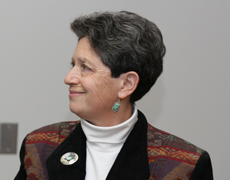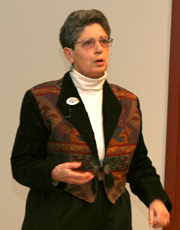 "Our identities change over an entire life cycle," said Dr. Anne Fausto-Sterling before a standing room only crowd at Wabash College Thursday.
"Our identities change over an entire life cycle," said Dr. Anne Fausto-Sterling before a standing room only crowd at Wabash College Thursday.
The celebrated professor of biology and gender studies at Brown University gave a public lecture after spending the day in Wabash biology and psychology classrooms.
Fausto-Sterling has further advanced her research in the fields of biology, gender, and the construction of sexuality. In 1993 she wrote the controversial "The Five Sexes: Why Male and Female Are Not Enough" for The Sciences. In her article, she suggested there are at least three so-called "intersexes" that go beyond normal male or female identification. Her research focused on earlier scientific studies of genital and chromosomal abnormalities and their roles in gender development.
"The nuances of sexual multiplicity among intersexuals cry out for more sophisticated analysis," she wrote in conclusion. "In the long view — though it might take generations to achieve — the prize might be a society in which sexuality is something to be celebrated for its subtleties, and not something to be feared or ridiculed."
In her lecture Thursday evening, Fausto-Sterling talked at length about the "more sophisticated analysis" she and her colleagues at Brown have undertaken. Along with colleagues Cynthia Garcia Coll, Deborah Schooler, and Meaghan Lamarre, Fusto-Sterling is blowing up the usual "nature or nurture" models applied to gender by scientists and psychologists.
A fellow of the American Association for the Advancement of Science, Fausto-Sterling and her colleagues have conducted a voluminous literature review of both scientific and psychological studies. They discovered very few significant differences between prenatal and infant boys and girls biologically: very little difference in brain size, physical strength, physical activity, and early language. There are some differences, she explained, but they are very small.
What her research has revealed are differences in cultural and social development in early childhood. "We’ve found there are very large differences when it comes to parental input," she said, citing studies that showed mothers speak to their infant daughters almost twice as often as their infant sons, for example.
Today Fausto-Sterling is applying dynamic systems theory to study interactions between parents and children ages four months to 14 months. Dynamic systems theory studies the ways in which cultural difference becomes bodily difference. By carefully reviewing massive amounts of well-orchestrated videotaped interactions, their study hopes to "develop a dynamic systems hypothesis that directly addresses the question of group differences."
 "We’re looking at change over time," she said. "What comes before has an effect on what follows; behaviors build on each other."
"We’re looking at change over time," she said. "What comes before has an effect on what follows; behaviors build on each other."
The researchers are following the interactions between mothers and their children (two boys and two girls) in regular weekly contact in a longitudinal study. In particular, they are studying speech patterns and tones of voice; the emotional affect of both parent and child; the level of motor training done and if it differs by gender; amount of eye contact between parent and child and vice versa; and the level of body image training — how the parent gives the child a sense of self.
"What we’re trying to do with this study… is to tease out the subtle dynamic systems, which I think is the key to discovering gender difference," she said. "Real training is the training of the body in ways that are very subtle.
"I’d like to get to the point where we can say this is a good way to study child development and gender development," she added.
"Can we learn something about the body and mind as a dynamic system?" she asked.
Her end goal is clear: "I’d like to stop dividing us up as "nature vs. nurture" and look at our bodies as an intricate system."